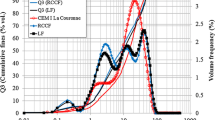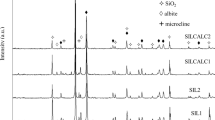Abstract
In many countries, major portions of construction and demolition waste (C&DW) consists of concrete waste [1]. The uses of recycled aggregate from concrete waste include both base/sub-base infrastructure and structural applications. Each application requires a different quality and therefore, a different treatment. When concrete waste is crushed, a certain amount of paste/mortar from the original cement mortar remains attached to the aggregate particles, which forms a weak, porous and cracky layer [2]. The use of recycled aggregate in new concrete requires a beneficiation process, which separates the natural aggregate from the attached cement paste/mortar. The clean natural aggregate is used as recycled aggregate, while the attached cement paste/mortar is of no use. As a result, the majority of concrete recycling studies focus on the recycled aggregate only, clean from the attached cement paste/mortar. This work focuses on the old cement paste/mortar itself.
Access provided by Autonomous University of Puebla. Download conference paper PDF
Similar content being viewed by others
Keywords
1 Introduction
In many countries, major portions of construction and demolition waste (C&DW) consists of concrete waste [1]. The uses of recycled aggregate from concrete waste include both base/sub-base infrastructure and structural applications. Each application requires a different quality and therefore, a different treatment. When concrete waste is crushed, a certain amount of paste/mortar from the original cement mortar remains attached to the aggregate particles, which forms a weak, porous and cracky layer [2]. The use of recycled aggregate in new concrete requires a beneficiation process, which separates the natural aggregate from the attached cement paste/mortar. The clean natural aggregate is used as recycled aggregate, while the attached cement paste/mortar is of no use. As a result, the majority of concrete recycling studies focus on the recycled aggregate only, clean from the attached cement paste/mortar. This work focuses on the old cement paste/mortar itself.
In this work, recycled cement paste fines are produced by different grinding processes. The processes include different grinding techniques; different grinding times and the use of grinding aids (GA) at different concentrations. Grinding aids have been extensively used in the comminution process of cementitious materials due to the reduction in energy consumption, carbon dioxide emissions and costs [3, 4].
2 Materials
Cement: The cement used in this study is Portland cement CEM I 52.5 N produced by Nesher Israel Cement Enterprises Ltd. The chemical and physical properties of the cement are presented in Table 1 (data obtained from Nesher).
Chemical Admixture: The chemical admixture used in this study is HTC 698 (Glenium SKY 698), a high range water reducing superplasticizer admixture based on polycarboxylic ether (PCE), with specific gravity of 1.079 and active/solid content of 30% (by mass).
Grinding Aids (GA): The type of grinding aids used in this study is triethanolamine (TEA), a liquid additive of molecular formula of N(CH2CH2OH)3, based on amino alcohols, with specific gravity of 1.12 and molecular weight of 149.19 g/mol.
3 Methods
Parent Cement Paste Production
The parent material is produced using cement, water and superplasticizer admixture (SP), with a water/cement ratio of 0.30. Preliminary tests are performed and the workability of the cement paste is adjusted by the addition of SP, achieving a 0.4% of the active/solid content (by mass) in relation to the mass of cement. Cement paste specimens are produced in 50 mm cubes molds. Curing is started one day after casting, when the specimens are removed from the molds and placed in water at (20 ± 1) °C for 7 days. After curing, the specimens are dried in oven at 105 °C until reaching constant mass and after, they are transferred to a low humidity room.
Cement Paste Fines Production
At 28 days from casting, the specimens are tested for compressive strength according to ASTM C109/C109M-2016a [5], followed by crushing in a jaw crusher and several grinding processes, including different grinding techniques (planetary ball mill and vibratory ball mill); different grinding times (15, 30 and 60 min) and the use of grinding aids (GA) at different concentrations (0.05, 0.1, 0.2%).
A planetary ball mill (Planetary Mono Mill Pulverisette 6 classic line) was used, with a zirconia grinding bowl of 80 ml and zirconia grinding balls of 10-mm diameter. TEA at different concentrations (0.05, 0.1, 0.2%) and grinding times (15, 30 and 60 min.) were used. A vibratory ball mill was used, with a material/cylpebs ratio of 1/20 (stainless steel cylpebs used).
The measurements of Particle Size Distribution (PSD) were performed using Malvern Mastersizer 3000 with isopropyl alcohol as dispersion liquid.
4 Results
Compressive strength at 28 days results in an average of 53.6 MPa with a standard deviation of 6.2 (25 cubes were prepared and tested). It should be noticed that the compressive strength refers to a 7-days strength due to the sample preparation process, where samples were are dried in oven at 105 °C and transferred to a low humidity room at the age of 7 days, stopping the further development of hydration. PSD results are presented in Fig. 1 and the parameters extracted from the test are summarized in Table 2.
In order to perform a better analysis and understanding, the curves from Fig. 1 are separated as follows in Figs. 2 and 3.
5 Conclusions
From the results, there is a clear tendency in the planetary mill samples, in which at the same concentration of GA, the shorter grinding (15 min) generates coarser particles and the longest grinding (60 min) generates finer particles, for all GA concentrations (Fig. 2). These results are confirmed by the parameters shown in Table 2. At the same grinding time, the tendency is not so clear. For 15 min grinding, samples with 0.1% and 0.2% TEA presented very similar results, while the 0.05% TEA presented coarser particles (Fig. 3, left). For 60 min grinding, the same tendency is found in particles larger than approximately 5 µm. However, below this size, samples with 0.1% and 0.2% TEA presented very similar results, while the 0.05% TEA presented finer particles (Fig. 3, right). For 30 min grinding, all the TEA concentrations presented similar results (Fig. 3, middle).
In the vibratory mill, the tendency is clear. A higher concentration of TEA generates finer particles and a lower concentration of TEA generates coarser particles (Fig. 3, middle). These results are confirmed by the parameters shown in Table 2.
It is interesting to notice that the same grinding time and the same TEA concentration using both methods (vibratory and planetary mills) presented different results, which proves that not only time and grinding aids affect the grinding efficiency but also the grinding technique and equipment. When comparing both techniques at the same TEA concentration, we can see that for all TEA concentrations, the vibratory mill (30 min) generates results similar to the planetary mill (between 15 and 30 min) for the finest portion of the sample (below 2-4 µm), and similar to the 15 min grinding (even coarser) for the portion above this size (Fig. 2).
Regarding solely PSD, the planetary milling seems to be a more suited technique for grinding cement paste into recycled cement paste fines.
References
Akhtar, A., Sarmah, A.K.: Construction and demolition waste generation and properties of recycled aggregate concrete: a global perspective. J. Clean. Prod. 186, 262–281 (2018)
Tam, V.W.Y., Tam, C.M., Le, K.N.: Removal of cement mortar remains from recycled aggregate using pre-soaking approaches. Resour. Conserv. Recycl. 50(1), 82–101 (2007)
Toprak, N.A., Altun, O., Aydogan, N., Benzer, H.: The influences and selection of grinding chemicals in cement grinding circuits. Constr. Build. Mater. 68, 199–205 (2014)
Sun, Z., Liu, Y.: A grindability model for grinding aids and their impact on cement properties. Adv. Cem. Res. 28(7), 475–484 (2016)
ASTM C109/C109M-2016: Standard Test Method for Compressive Strength of Hydraulic Cement Mortars (Using 2-in. or [50-mm] Cube Specimens) (2016)
Author information
Authors and Affiliations
Corresponding author
Editor information
Editors and Affiliations
Rights and permissions
Copyright information
© 2020 RILEM
About this paper
Cite this paper
Kulisch, D. (2020). The Effect of Grinding Process on Recycled Cement Paste Fines. In: Kovler, K., Zhutovsky, S., Spatari, S., Jensen, O. (eds) Concrete Durability and Service Life Planning. ConcreteLife 2020. RILEM Bookseries, vol 26. Springer, Cham. https://doi.org/10.1007/978-3-030-43332-1_4
Download citation
DOI: https://doi.org/10.1007/978-3-030-43332-1_4
Published:
Publisher Name: Springer, Cham
Print ISBN: 978-3-030-43331-4
Online ISBN: 978-3-030-43332-1
eBook Packages: EngineeringEngineering (R0)







